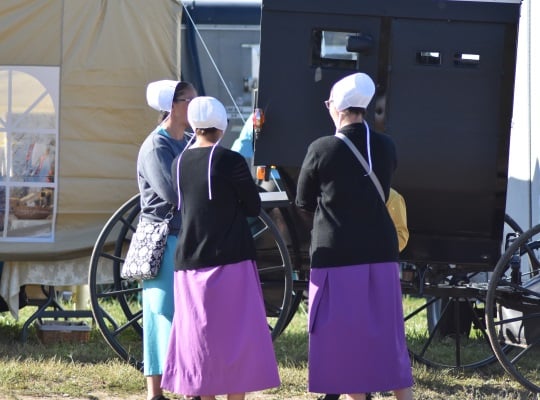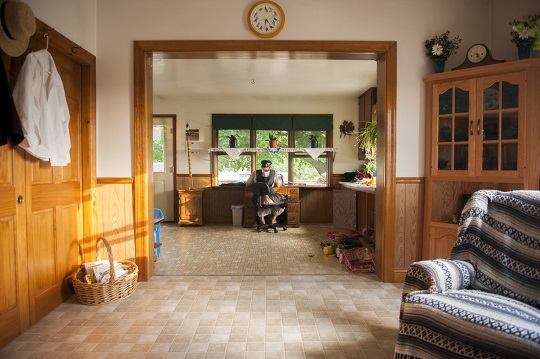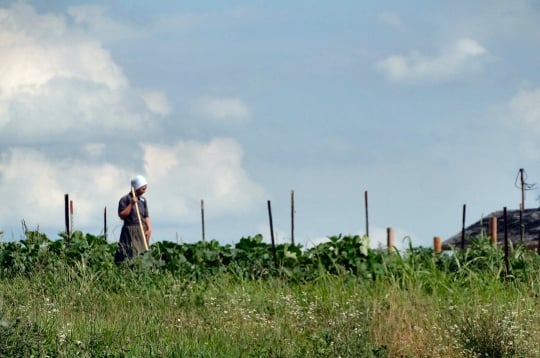9 Ways Amish Women’s Lives Have Changed
How have Amish women’s lives changed in the last 50 years? Fran Handrick recently completed a PhD entitled “Amish women: work and change – an investigation into the lives of Amish women in Pennsylvania and Ohio” at the University of Birmingham.

Fran is here to share some things she learned with us today – specifically nine areas where she discovered Amish women’s lives have changed, including gardens, clothes-making, English friends, and free time. I’ll let Fran take it from here.
How this project came about
In 2011, I began work on a Ph.D to look at the changes that had taken place in the lives of Amish women as a result of the move out of farming of significant numbers of Amish in Pennsylvania. I found several pieces of research which suggested that the lives of Amish men had been examined but almost nothing that had been written about how the lives of their wives and families had been affected. So, I wanted to see if I could identify what had changed for the women and how they felt about these changes.
My research was carried out among old Order Amish women in Pennsylvania and both Old and New Order in Ohio. Thirty-eight women in total, roughly split between the two groups. There were no significant differences between Old and New Order. I did not interview any women in the strictest group, the Swartzentruber Amish, and am aware that life for them could be considerably different.
I lived with an Amish family during each of my four field trips. In addition, I have made further trips staying with Amish friends that have supported and added to my knowledge.

A small study in 2009 (Feeley 2009:11) identified that Amish women saw their role as working at home, half of them said that housework and homemaking was the primary role. One-third said that caring for the family was the main work of an Amish woman. The women I interviewed largely agreed with this but felt it was not exclusively so. Their views included that the older Amish women needed to be working with younger married women to ensure that the ‘Amish way’ of doing things was clearly taught to these younger women. They also saw it as an opportunity to socialise with other women.
How has Amish life changed?
During my fieldwork, meeting women, my first research question to them was “Can you tell me how Amish life has changed in the last thirty years?” Women in both states talked about how they have been affected by the move out of farming, how their houses have changed, life in the kitchen, working life, social life, gardening, and virtually all noted an increased contact with the English.
1. Smaller families
Within those topics some mentioned that families are getting smaller (they are still larger than the average non-Amish family) and a consequence of that is that the women have less work to do at home.
Mention of smaller families greatly impacts the work of an Amish wife. Bearing in mind that historically, the woman will make all the clothes for her family, a smaller family means there are few people whose clothes need to be made and even the way these clothes are made has changed.
2. Electric sewing machines
Where previously women would have a treadle sewing machine that did not require electricity, depending on the local Ordnung, (the rules that govern life in the church district) some women were now able to avail themselves of the latest electronic sewing machines which has greatly speeded up the process.

One woman talked to me about how these electronic machines provide a temptation for “a little bit of fancy stitching here and there”, and how she works to avoid that. These machines can be powered by battery or solar, or by generated electricity, depending on the Ordnung.
3. Less clothes-making
In some communities in both Pennsylvania and Ohio, some women have set up as dressmakers, so that, for women who do not enjoy sewing, they can purchase clothing for the family without having to make all of it. In some places, the dressmakers sell from their homes, as if it were a shop. This is a big change for women that they can now purchase men’s and children’s clothing from someone in the community who knows the rules well enough that they can make clothing that comply with them.
One woman in Ohio told me that she was not a good needlewoman and decided to start buying clothes for her family when she realised it was better for her to do that, than spend hours doing something she did not enjoy. In other communities, this is not common.

A Bishop’s wife in Ohio, told me quite categorically that it was not possible to buy Amish clothes in any shop, and all Amish women must make their own clothes. I did not like to argue, but I had been just the previous day in a house where Amish clothes were being sold, so I knew that what she was telling me, whilst it might be true in her community, was not true everywhere.
4. Less butchering
I wanted to add that none of “my” women did their own butchering at home, even if they were still farming. One woman told me that her neighbours who are Swartzentruber do their own butchering, but she doesn’t buy meat from them as “she doesn’t trust their hygiene”, instead she prefers to get a driver to take her eight miles away to an Amish family who have a Meat and Deli store and purchase from them.
5. Smaller gardens
Most of the women I interviewed in Pennsylvania told me that their gardens were smaller now than they used to be, and in Ohio, women told me the same. Traditionally, the gardens were planted mostly for food for the family and very little space was given over to flower gardens. Some women told me that they plant fewer vegetables now than previously, because it is possible to buy them more cheaply at a Produce Auction.

The impact of smaller vegetable gardens is that there is less food to can at the end of the season, although purchasing it at an auction may mean that they process and can what they have bought, so it doesn’t necessarily mean that they have less to do in the summer months.
That said, there is some difference between what Amish women mean by a smaller garden and what an English person might mean by it. One Amish woman, Sadie, told me that now that only she and her husband are at home, the children have married and left home, she would “only” be planting twenty-seven vegetables, instead of the usual forty to fifty!
6. More free time to fill
Many women made the point to me that since families and gardens are now smaller than they were in the past, they are not as busy as they might have been previously; smaller families means there are fewer people to look after, fewer clothes to make, a smaller number of people to cook for and sometimes not needing to cook a midday meal at all if their husbands and children are working away from home.
Smaller gardens exist because they are not needing to feed so many people in the family and therefore there is less canning of produce to do for the winter. All of which, said the women, means that they have more discretionary time, and they need to find things to do to fill up that time.
I met women who were volunteers for different groups within their community, who were unpaid helpers in Amish schools, who worked in Thrift stores or supported the workers at homes for the mentally ill or learning disabled. They all agreed that their own mothers would not have done those things because they would have been too busy.
7. Different daily “rhythm” of family life
The move out of farming means that either the husband is ‘working out’ ie away from the farm and family, each day. Or it may mean that there is a non-farm business on the farm, possibly in the buildings that were previously farm buildings.
Such businesses include farm-related enterprises or it may mean a small manufacturing enterprise. I visited a family who make bed frames and mattresses in buildings that previously were used for raising pigs, another family make the winding gear for those washing lines high up in the air, often seen on Amish farms, others have woodwork or small engineering businesses.

For those women whose husbands are working out, going daily to a job, this is a big change for them, as they no longer have their husband at home during the day. They rhythm of family life has changed as they commute to a workplace, and return home in the evenings, just as many English do. Running a business from home, may also mean increased contact with English, at their home, who might be customers or suppliers.
8. More English friends
Making friends with English seems to be on the increase too, compared with their parents generation. Inviting English friends to stay in their home as well as going to stay with their friends. I have stayed a number of times with Amish friends, even before I was thinking of doing the research.
It was because I saw changes taking place when I stayed with them, that our friends seemed not to notice, that prompted me to think there was a piece of research waiting to be done. About meeting more English, more than half of the women told me they have English friends that they have met through a shared interest – horse shows and meets, auctions, quilt exhibitions or benefits auctions or when they were travelling, whom they have kept in touch with.
9. More travel
I was surprised by how many women told me that since they left the farm they like to travel around the US and Canada and this was another way to meet people. A small number had even been to Switzerland to see where their ancestors came from and a smaller number had been to Israel. I was surprised to meet a New Order couple with a travel business who specialise in taking Amish and Mennonites on tours of the Holy Land.

But I was shocked when I discovered that going on cruises is also something that some Old Order couples told they enjoy. I met a number of women who had done that, usually with friends in a small group. More recently, I met some young couples who had been on cruises after their wedding celebration, where traditionally young marrieds would have toured around their extended family to celebrate their married status.
Some change is necessary
Virtually all the women I interviewed expressed contentment with their lives, they identified things that have changed and been beneficial to them like refrigeration in the kitchen, the advent of washing machines, and more recently, automatic washing machines. They noted the opportunity to work out when the children have left school and considered this as an enrichment of their lives. They mentioned the advent of ‘Amish taxis’ as something which had enabled them to make visits, take trips and keep up with friends who move to other settlements, as well as routine trips to Walmart, Costco and such places.
They acknowledged that some features of their lives now could have a detrimental effect on family life (Mentioning eating out at restaurants or getting ‘take outs’ as examples) but were aware that this added variety for their teenagers and for a family outing. Most of the women seemed to feel a certain amount of change and adaptation was necessary for survival.
Fran’s Bio
I was almost fifty eight when I started my PhD. I had had a career in Occupational Guidance and Change Management for more than thirty years but had always been interested in Plain groups – Hutterites, Old Order Mennonites and Amish, never imagining I would have the opportunity to meet any. I am not only English, but live in England, so that meeting any of these people involves a major spending commitment to travel for an extended period which is costly in time and money. I had some major health challenges beginning just after I started which included a serious stroke, cancer and four surgeries. But I don’t give up easily and eight years later, I completed my PhD.
A big thank-you to Fran for sharing these insights with us. If you enjoyed what you learned here, I encourage you to check out Fran’s full thesis for more.
Images: three Amish women – Jim Halverson; clothesline – Lehman’s; garden – Cindy Cornett Seigle; canyon – daveynin






wow! :O
Very surprised! :O God is good all the time. 😀
Due to having Amish friends over the years I have noticed some of the changes Fran talks about. Going to visit Amish friends that had a gas stove, refrigerator, and lights about blew me away! We have an Amish made Ashland cookstove in the kitchen, this couple didn’t and they’re Amish! Now they have rubber on their buggy wheels, so all you hear is the clip clop of the horses hooves on the road. Their family consists of only three children and we’ve wondered if they were using birth control. For the most part all of our Amish friends have had large families,so,seeing only three kids is different.
Seeing men and boys with boughten shirts was new. The Amish that I went to school with never had a row of buttons down the front of their shirts. Their shirts were like a pajama top that slipped over their head with maybe one button.
Footwear changes has been happening over the years as well. Seeing the girls with fancy flip flops, and crocs on both girls and boys seemed “fancy”!
Indoor plumbing has certainly been a plus for many families. Our four kids refused to go to an outhouse and would wait until a gas station popped up on the way to grandma’s house!
So, Erik, and AA friends, I’ll leave it at that.
Women
I know she said she didn’t visit Swartzentruber amish. I don’t see the any of those changes with my neighbors who are.
I’m glad for the changes she did find among other Amish.
Good read!
An ancient English...
I lived in an area with an Amish community and a Seventh Day Adventist community. Both taught me so much. As English, I worked on occasion as a carpenter with the local folks. I speak English and have an understanding of spoken Polish and Russian. The Amish preferred to speak in a German dialect that I didn’t understand. I don’t know if the dialect is a written language. They would tease me. They were kind folks.
My aunt grew up in a Tennessee orphanage. She was a lovely ginger lady. She often told me that I needed to know my people. As an orphan, she never knew her people. I think about her every day. She was so kind and so loving. I think she’s the
I giggle every time I think about the craftsmen I worked with. They would not use corded electrical tools. But they used the primitive battery powered tools of the era…
Wonderful work!
Fran, thank you so much for sharing your work with us, both in the form of this post and your complete thesis, which I look forward to digging into! Your work is a wonderful companion to Karen Johnson-Weiner’s new book, as she does much of her research with the Swartzentruber Amish.
Thanks
Thanks Erik for sharing this topic.
Very interesting for my anthropology research.
One older Amish man said look around. Pointing to lights powered by electricity in his home and a cell phone on the table.
“I don’t know how much longer we can hang on.”
He said the younger ones want more. The horse is out of the barn and he doesn’t think it can be brought back in.
They got a taste of modern conveniences and it’s hard to “go back.”
Yeah...
I know this site is usually full of optimistic Amish population projections but one does get the sense they are slowly but surely assimilating, which does call continued growth into question. Same goes for their Mennonite cousins in Latin America who keep moving further and further into the jungle to escape the modern world.
Hasidic Jews use modern technology and have high growth rates but my sense is they are much more insular.
9 Ways Amish Women’s Lives Have Changed
I am not surprised that their lives have change. I’ve notice that authors of Amish Fiction have documented some of those changes in their storylines as well.
Smaller Families, more birth control?
I have a question for Ms.Handrick. I very briefly reviewed your thesis. While you point out that Amish family sizes are smaller,I did not find where you discuss the issue of whether they have made this change by using birth control. All I found was this statement: “…families are still significantly larger than non-Amish families in America, averaging seven children per family. A reason for this is because they do not routinely practice artificial birth control.” That raises the question as to whether or not they actually use birth control at all, or are allowed to use it. (I would note that, the Amish community here in SW Wisconsin does not appear to have reduced family sizes.) Clearly if Amish women are to make any major changes in their life style, access to birth control would be critical. I have assumed that would not be permitted by Ordnung.